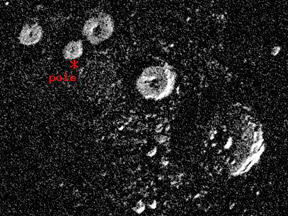This picture was made with a radar. It shows the area around the North Pole of Mercury. There are some white circles or "doughnuts" in the picture. The white circles might be ice at the bottom of meteor craters.
Click on image for full size
Image courtesy of NAIC - Arecibo Observatory, a facility of the NSF (J. Harmon, P. Perrilat, and M. Slade).
Mercury's Poles
Most planets are tilted. Their North and South Poles are not straight up and down. Earth is tilted a medium amount. Uranus is tilted a lot. Mercury is hardly tilted at all. It is tilted less than any other planet. Mercury's North and South Poles are straight up and down.
Planet's that are tilted have seasons. Earth is tilted. That's why we have seasons on Earth. Mercury isn't tilted, so it doesn't have seasons.
If you were at one of Mercury's poles, you would see a strange sight. The Sun would never rise or set. It would always be at the horizon. It would always look like it was in the middle of rising or setting. If you were inside a crater, it would always be dark. The hill around the rim of the crater would block the sunlight.
Some of those dark craters near the poles might have ice in them. Scientists have taken radar images that may show ice. It would be very strange to find ice on Mercury. It is very, very hot on Mercury because Mercury is the planet closest to the Sun. The temperature is sometimes as high as 452° C (845° F). Still, there might be ice in the bottom of craters near the poles where the Sun never shines.
You might also be interested in:

What types of instructional experiences help K-8 students learn science with understanding? What do science educators teachers, teacher leaders, science specialists, professional development staff, curriculum designers, school administrators need to know to create and support such experiences?
...more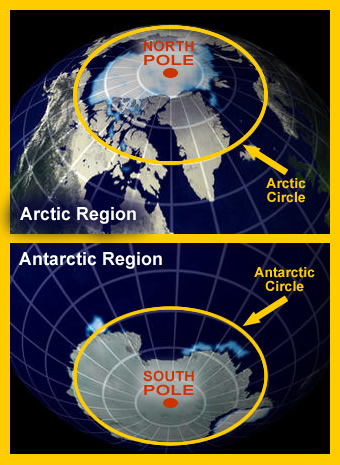
The Polar Regions are the areas that are near Earth's North and South Poles. The area near the North Pole is called the Arctic. Most of the Arctic is ocean water with ice on it. The ocean is called the
...more
The Earth is rotating around an axis (called its rotational axis). Some objects rotate about a horizontal axis, like a rolling log. Some objects, such as a skater, rotate about a vertical axis. The Earth's
...more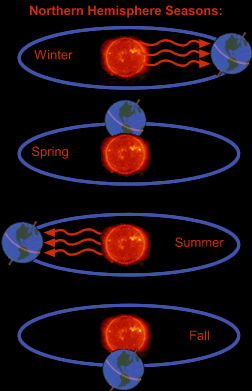
During the year, the seasons change from winter to spring to summer to fall. Why does it happen? Seasons depend on the Sun! The seasons happen as the Earth, travels in a loop around the Sun each year.
...more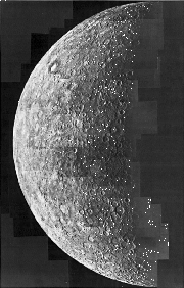
A wide variety of craters ranging in size from 100 meters to 1300 km across can be seen in the Mariner 10 images of Mercury's surface. These include: (1) craters in young terrain, (2) double craters,
...more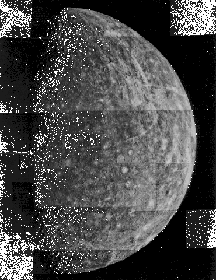
Images of the surface of Mercury obtained by Mariner 10 showed a planet covered with craters, looking very much like the Earth's Moon. During its three passes by the planet, Mariner 10 took pictures of
...more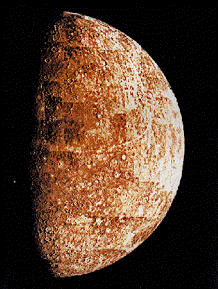
Mercury, like the other planets, is believed to have formed in the earliest stage of the evolution of the solar system as dust came together to form even larger clumps and eventually small planets or
...more
Mercury, the innermost planet of the solar system, is a little bigger than the Earth's Moon. The surface of the planet is covered with craters, like the Moon, but temperatures there can reach over 80
...more


